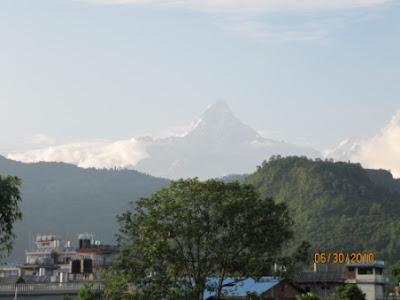









During the days since Claire and Sajal’s wedding we have been unwinding, and day after day a few more guests have gone home from both sides of the family. Deval, Laura, and her parents left, then Don, Ian, and Leyla, then Antonio and the Lloyds, and now only Nicole, some of Sajal’s family members, and I are left here. Nicole had planned to go yesterday, but because of the weather no planes left Pokhara. Today she and Bhuwon hope to fly out, and tomorrow the rest of us will go home. We all spent the night at Claire’s new home with Sajal, Bhuwon, Rajya, Swopnil, and Sworupa last night. The monsoon that held off throughout the wedding has finally settled in, and it rained all night.
On Monday we visited a Buddhist gumba, or school, and after that the Ghorka Museum celebrating the military fighters who serve in the British army, and a cave. After that Claire and I came over to the house to begin getting her moved in and to help make and eat momos.
On Tuesday several of us rented bikes and rode around town. Claire and Sajal had to leave us mid-morning, and the rest of us split up, and Teri and I ended up visiting the Mountain Museum, where we had lunch in a wonderful little restaurant, but only after I got hit by a microbus that turned without looking (only bruises, nothing bad except that my outrage scared the driver).
On Wednesday we all, along with Sajal’s family, drove up the mountains to Lumle, a little village at a much cooler altitude, where we walked through a traditional village that had once been a trekker’s stopover, before the road to it was built, and where Bhuwon directed a regional agricultural station for 19 years, and where Sajal spent much of his early life. We saw the house where he grew up. It was a beautiful, refreshing outing far from the heat of the valley.
The past couple of days we have not done much but take walks, shop a little, cook, play cards, and relax. I’ve toured the gardens around the house, where so many fruit trees grow: Asian pears, bananas, mangoes, papayas, mandarin oranges, limes, and several fruits I don’t know, as well as corn, coffee, beans, squash, greens, tomatoes, mint, and various flowers, including 21 varieties of orchids.
Yesterday we had lunch with Surmila Auntie, who lives nearby and who hosted Claire this spring when she visited Pokhara, and Claire and I took a walk to see the Seti River Gorge nearby here. Last night when the eleven of us in the house were finding places to sleep I chose the balcony where the windows are open on three sides and I could hear the rain falling all night and feel its cooling mist. It is early morning now, still raining, and occasionally people are walking by under their umbrellas. Four roads crisscross in a flattened x shape in front of the house, and directly across the street is the Buddhist Bihar that Sajal’s great aunt founded, where one of his older relatives lives as a monk. It is already lighted, but it is the only lighted place in sight. A rooster crows occasionally.
Claire will go to Kathmandu this week to finish up her work there, and after that she will begin to figure out what she will do here in Pokhara. Her work at TPO Nepal in Kathmandu has given her a sense of what the mental health and social work needs are here in Nepal, and how she can use her skills and education especially in Pokhara where there are so few services available. But since TPO Nepal decided not to open an office here, she will have to be creative and entrepreneurial in figuring it out. She is in the best of settings for this, since Bhuwon has experience in starting up agencies in his own field of conservation biology and will help her think it through. But before she settles in too much she will be traveling to the U.S. next month for Ian’s wedding.











































